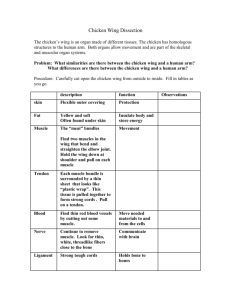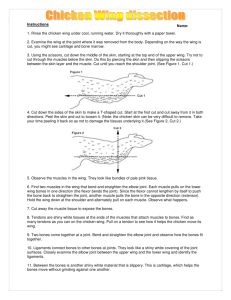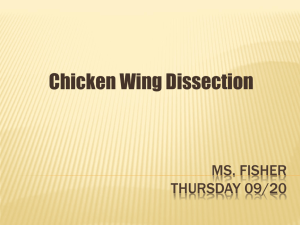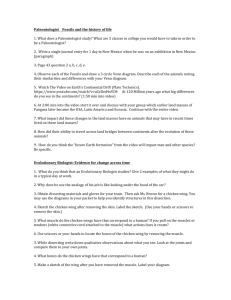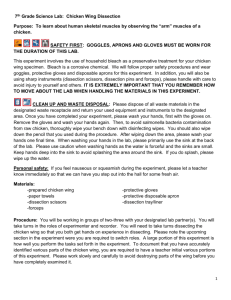Chicken Wing Dissection
advertisement
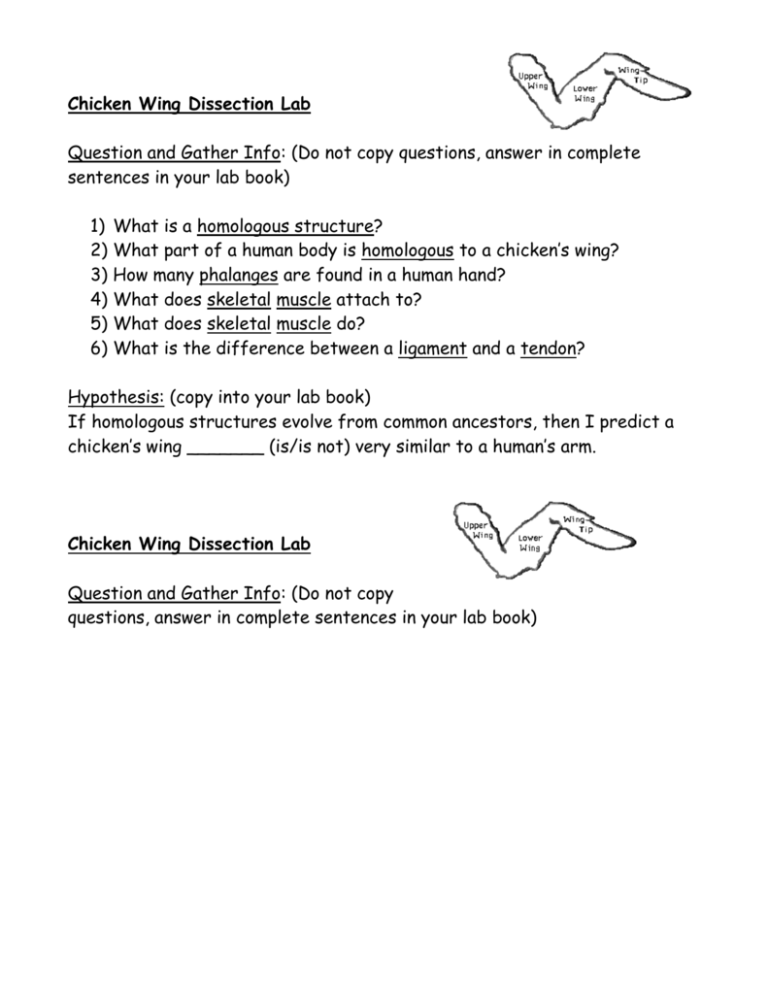
Chicken Wing Dissection Lab Question and Gather Info: (Do not copy questions, answer in complete sentences in your lab book) 1) 2) 3) 4) 5) 6) What is a homologous structure? What part of a human body is homologous to a chicken’s wing? How many phalanges are found in a human hand? What does skeletal muscle attach to? What does skeletal muscle do? What is the difference between a ligament and a tendon? Hypothesis: (copy into your lab book) If homologous structures evolve from common ancestors, then I predict a chicken’s wing _______ (is/is not) very similar to a human’s arm. Chicken Wing Dissection Lab Question and Gather Info: (Do not copy questions, answer in complete sentences in your lab book) Chicken Wing Dissection Use the diagram below to identify the bones and muscle groups of the wing PART 1: 1. Identify who will be the dissector and who will be the recorder. Record this in Data Table. 2. Put on protective gloves. Thorough washing of hands, countertop and instruments have to be done at the end to prevent salmonella contamination. 3. Your teacher will give you a chicken wing. Rinse it well with cool water, dry it with paper towels, and place it in a dissecting tray. 4. Examine the wing at the point where it was removed from the body. Depending on the way the wing is cut, you might see cartilage and bone marrow. 5. Carefully extend the wing to find out how many major parts it has. 6. Using the scissors, cut down the middle of the skin, starting at the top end of the upper wing. Try not to cut through the muscles below the skin. Do this by piercing the skin and then slipping the scissors between the skin layer and the muscle. Cut until you reach the shoulder joint. (See figure 1, Cut 1.) Only cut through the skin. CAUTION: Cut away from your body and your classmates. 7. Cut down the sides of the skin to make a T-shaped cut. Start at the first cut and cut away from it in both directions. Peel the skin and cut to loosen it. 8. The chicken skin can be very difficult to peel. Take your time peeling it off. Cut around the skin just below the tip of the wing and peel off the lower part. Leave the skin at the very tip of the wing. 9. Look for yellowish tissue clumped together beneath the skin. This is fat tissue, made of fat cells. Human fat cells looks the same way. Look on the inside of the skin you removed to find fat. *Draw an illustration of the fat cells in your Data Table in the Part 1 section. 10. Examine the muscles, the bundles of pink tissue around the bones. Find the two groups of muscles in the upper arm. 14. Locate the bicep, locate the tricep. Hold the wing at the shoulder, and alternately pull on each muscle group, observe how the chicken wing moves. 15. Examine the durable white tissue that connects the muscle to the bone. This tissue is called a tendon. Locate where each tendon attaches to a bone. *Raise your hands to get your Part 1 stamp. You will need to show your teacher the bicep, tricep, a tendon, and how they make the wing move. PART 2: 1. The humerus is located in the upper arm, the radius and ulna are in the lower arm. Use the ruler provided, measure the length of the humerus in cm, also measure the length of the lower arm (measure the radius and ulna as one, you do not have to measure them separately) *Record the lengths of the bones in the Part 2 section of your Data Table. Find the two groups of muscles in the lower arm. Use a blunt probe to separate the muscles. Hold down the arm at the elbow, and alternately pull on each muscle group. 2. Try to make the very tip of the wing move. This is the same as you moving the phalanges in your hand. 3. Grasp the tip of the wing, this is the “hand” of the chicken. See if you can feel how many phalanges the chicken has. *In your Data Table, in Part 2 record how many phalanges (digits) you think the chicken has. PART 3: 1. Locate the elbow joint of the chicken. Remove the bicep by cutting the tendons and peeling the muscle away from the bone. 2. Remove all the remaining muscle around the elbow joint to expose the bones of the chicken wing. 3. Ligaments connect bone to bone and can be found where two bones come together. They appear white and ribbon-like. Find the ligaments. 4. Cut the ligaments at the joint between the upper and lower wing. Examine how the bones fit into each other. 5. Use the diagram below to try to determine what type of a joint it is. *In your Data Table record what type of a joint you think it is. Record it in the box labeled Part 3 Joint Type. 6. The very ends of the bones are where cartilage is located. Observe what the ends of the bones look like. 7. Try snapping a bone in two, any red material in the inside is red bone marrow. *Draw a picture of what you observe inside the bone after you have snapped it in your Data Table. Draw it in the box labeled Part 3 Bone Structure. CLEAN UP Dispose the chicken parts according to your teacher's instructions. Wash your hands with soap and water. Thoroughly wash the lab countertop with cleaner and paper towels. Thoroughly wash the scissors with hot soapy water and brush. Set instruments and tray aside to dry. Illustration of Fat Cells Part 1 Stamp Bone Lengths Number of Phalanges Part 1 Part 2 Length of Humerus: ______cm Length of Radius & Ulna _______cm Bone Structure Illustration Type of Joint Part 3 QUESTIONS Label the following: 1. Identify the bones A. _________________ B. _________________ C. _________________ D. _________________ F. _________________ 2. Draw in and label the bicep muscle. 3. Draw in and label the tricep muscle. 4. Label (with an arrow) the direction the radius and ulna move when the triceps contract. 5. What are 3 similarities the chicken wing structure shares with your arm: a)___________________________________________________ b)___________________________________________________ c)___________________________________________________ 6. What are 2 differences between the chicken wing structure and your arm’s structure: a)___________________________________________________ b)___________________________________________________ 7. Label the ball and socket joint, hinge joint, and the gliding joint in the diagram. 8. Where is cartilage found and what is it’s function. Describe how it looked during Part 3 of the dissection. 8. When you eat a chicken wing, what type of tissue are you eating?________________________ 9. What type of muscle tissue did you see in the lab? (Circle one) smooth skeletal cardiac 10. After doing the dissection, do you think the chicken wing is homologous to the human arm? Explain your answer__________________________________________________________ ______________________________________________________________________________ ______________________________________________________________________________ ______________________________________________________________________________ \
